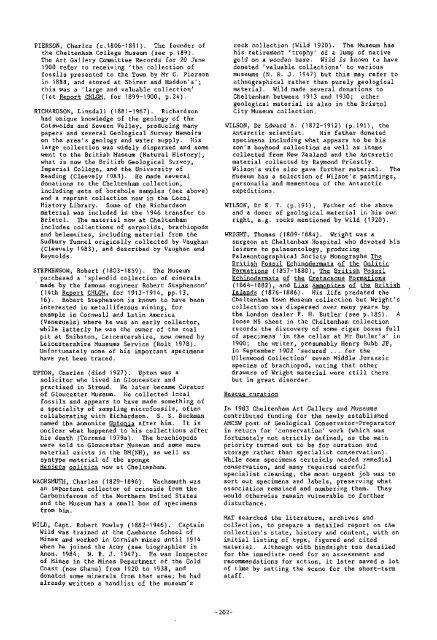Number 5 - Geological Curators Group
Number 5 - Geological Curators Group
Number 5 - Geological Curators Group
Create successful ePaper yourself
Turn your PDF publications into a flip-book with our unique Google optimized e-Paper software.
PIERSON, Charles (c.1806-1891). The founder ofthe Cheltenham College Museum (see p.189).The Art Gallery Committee Records for 20 June1900 refer to receiving 'the collection offossils presented to the Town by Mr C. Piersonin 1888, and stored at Shirer and Haddon's';this was a 'large and valuable collection'(1st Reoort CHLGM, for 1899-1900, p.24).RICHARDSON, Linsdall (1881-1967). Richardsonhad unique knowledge of the geology of theCotswolds and Severn Valley, producing manypapers and several <strong>Geological</strong> Survey Memoirson the area's geology and water supply. Hislarge collection was widely dispersed and somewent to the British Museum (Natural History),what is now the British <strong>Geological</strong> Survey,Imperial College, and the University ofReading (Cleevely 1983). He made severaldonations to the Cheltenham collection,including sets of borehole samples (see above)and a reprint collection now iq the LocalHistory Library. Some of the Richardsonmaterial was included in the 1946 transfer toBristol. The material now at Cheltenhamincludes collections of serpulids, brachiopodsand belemnites, including material from theSudbury Tunnel originally collected by Vaughan(Cleevelv 1983). ,.and described bv Vauehan andReynolds.STEPHENSON, Rohert (1803-1859). The Museumpurchased a 'splendid collection of minerals. made by the famous engineer Rohert Stephenson'(14th Report CHLGM, for 1913-1914, pp.13,16). Robert Stephenson is known to have beeninterested in metalliferous mining, forexample in Cornwall and Latin America(Venezuela) where he was an early collector,while latterly he was the owner of the coalpit at Snihston, Leicestershire, now awned byLeicestershire Museums Service (Rolt 1978).Unfortunately none of his important specimenshave vet been traced.UPTON, Charles (died 1927). Upton was asolicitor who lived in Gloucester andpractised in Stroud. He later became Curatorof Gloucester Museum. He collected localfossils and appears to have made something ofa speciality of sampling micrafossils, oftencollaborating with Richardson. S. S. Buckmannamed the ammonite after him. It isunclear what happened to his collections afterhis death (Torrens 1979a). The brachiopodswere sold to Gloucester Museum and some morematerial exists in the BM(NH), as well assyntype material of the spongeReniera oolitica now at Cheltenham.WACHSMUTH, Charles (1829-1896). Wachsmuth wasan important collector of crinaids from theCarboniferous of the Northern United Statesand the Museum has a small box of specimensfrom him.WILD, Capt. Rohert Pawley (1882-1946). CaptainWild was trained at the Camharne School ofMines and worked in Cornish mines until 1914when he joined the Army (see biographies inAnon. 1984; N. R. J. 1947). He was Inspectorof Mines in the Mines Department of the GoldCoast (now Ghana) from 1920 to 1938, anddonated some minerals from that area; he hadalready written a handlist of the museum'srock collection (Wild 1920). The Museum hashis retirement 'trophy' of a lump of nativegold on a wooden base. Wild is known to havedonated 'valuable collections' to variousmuseums (N. R. J. 1947) but this may refer toethnographical rather than purely geologicalmaterial. Wild made several donations toCheltenham between 1913 and 1930; othergeoloaical material is also in the BristolCity Museum collection.WILSON, Dr Edward A. (1872-1912) (p.191), theAntarctic scientist. His father donatedspecimens including what appears to be hisson's boyhood collection as well as itemscollected from New Zealand and the Antarcticmaterial collected by Raymond Priestly.Wilson's wife also gave further material. TheMuseum has a selection of Wilson's paintings,personalia and mementoes of the Antarcticexpeditions.WILSON, Dr E. T. (p191 Father of the aboveand a donor of geological material in his ownright, e.g. rocks mentioned by Wild (1920).WRIGHT, Thomas (1809-1884). Wright was asurgeon at Cheltenham Hospital who devoted hisleisure to oalaeontoloev. -,. ~roducineL UPalaeontographical Society Monographs TheBritish Fossil Echinodermata of the OoliticFormations (1857-1880), The British FossilEchinodermata of the Cretaceous Formations(1864-1882), and Lias Ammonites of the British ,(1876-1886). His life predated theCheltenham Town Museum collection but Wright'scollection was dispersed over many years bythe London dealer F. H. Butler (see p.185). Aloose MS sheet in the Cheltenham collectionrecords the discovery of some cigar boxes fullof specimens 'in the cellar at Mr Butler's' in1900; the writer, presumably Henry Bubb JP,in September 1902 'secured ... for theUllenwood Collection' seven Middle Jurassicspecies of brachiopod, noting that otherdrawers of Wright material were still therebut in great disorder.Rescue curationIn 1983 Cheltenham Art Gallery and Museumscontributed funding for the newly establishedAMCSW post of <strong>Geological</strong> Conservator-Preparatorin return for 'conservation' work (which wasfortunately not strictly defined, as the mainpriority turned out to be for curation andstorage rather than specialist conservation).While sme specimens certainly needed remedialconservation, and many required carefulspecialist cleaning, the mast urgent job was tosort out specimens and labels, preserving whatassociation remained and numbering them. Theywould otherwise remain vulnerable to furtherdisturbance.MAT searched the literature, archives andcollection, to prepare a detailed report on thecollection's state, history and content, with aninitial listing of type, figured and citedmaterial. Although with hindsight too detailedfor the immediate need for an assessment andrecommendations for action, it later saved a lotof time by setting the scene for the short-termstaff.
















